This trip in three words: Really Big Cacti. Truly, the saguaro cactus is the sequoia of its world – and it was amazing to see so many in Saguaro National Park, home to the world’s largest concentration of these giants that have come to be a symbol of the Southwest.
In a few more words: This trip also included some sights in Tucson and in the storied town of Tombstone. It was a fun winter getaway – and even after just a few days, the saguaros felt like friends to whom we were sad to say goodbye!
– feature film –
See the occasion come alive in these video highlights!
day 1 • 02.25.23
Traveling to Tucson
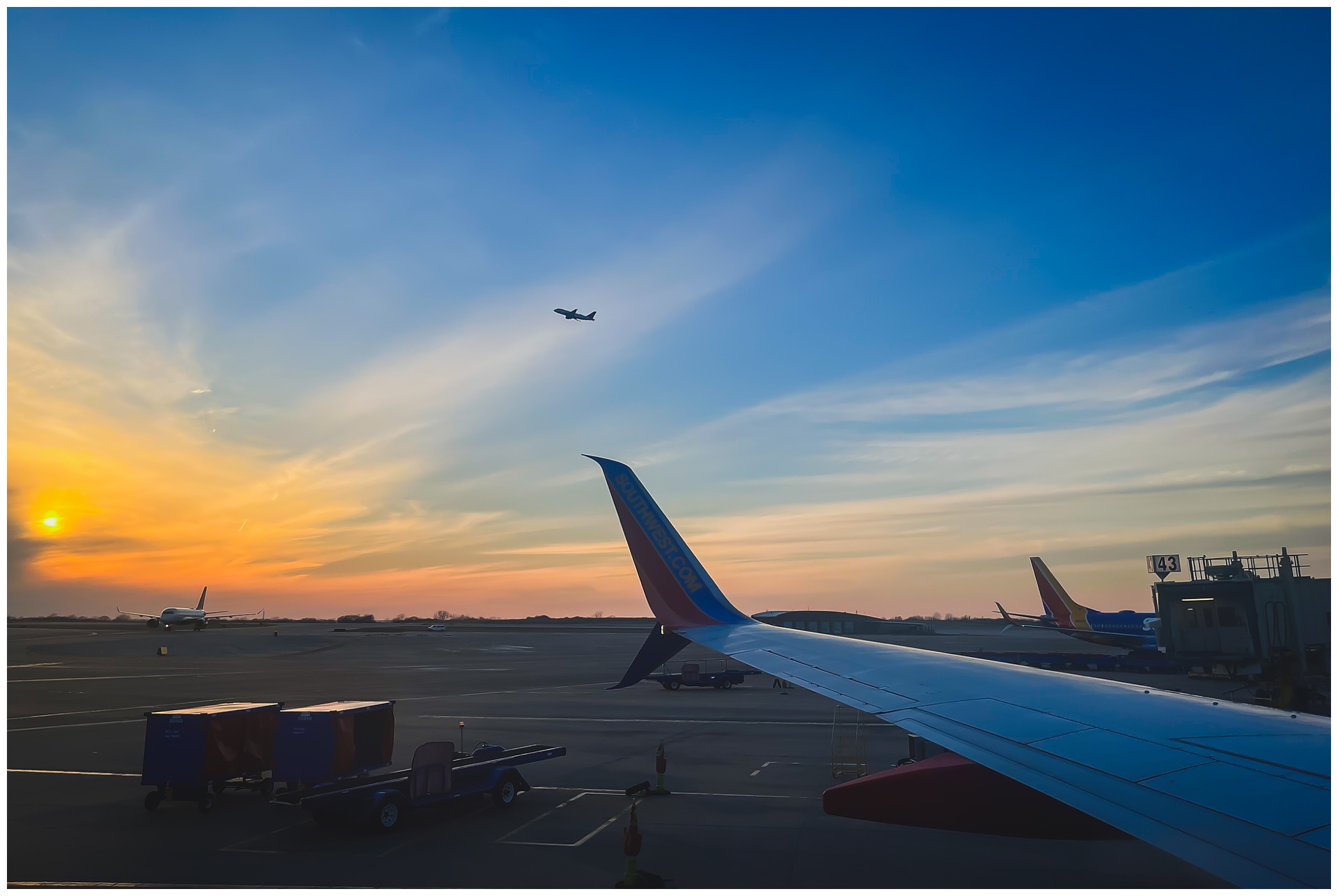 Another interesting detail of this trip was flying out of Kansas City’s old airport terminal and arriving home to the new one! We left as the sun was setting and chased the light out West, with Hawaii photos keeping me busy along the way. You know you’re in a travel season when the work from one trip “travels” into another!
Another interesting detail of this trip was flying out of Kansas City’s old airport terminal and arriving home to the new one! We left as the sun was setting and chased the light out West, with Hawaii photos keeping me busy along the way. You know you’re in a travel season when the work from one trip “travels” into another!

day 2 • 02.26.23
Saguaro National Park West (Tucson Mountain District)
 The city of Tucson divides Saguaro (pronounced suh•waa•row) National Park into two districts. We started on the west side of the park, which abuts the Tucson Mountains. And although it was chilly enough we wore jackets most of the day, I tried to make sure the saguaros on my shirt got a little bit of visibility!
The city of Tucson divides Saguaro (pronounced suh•waa•row) National Park into two districts. We started on the west side of the park, which abuts the Tucson Mountains. And although it was chilly enough we wore jackets most of the day, I tried to make sure the saguaros on my shirt got a little bit of visibility!

 Our first stop was the visitor center, where Seth found this soap that basically changed his life. (That’s perhaps a slight exaggeration, but it does smell very good, and he does like it very much.) I found these two hats I couldn’t decide between – even with the help of photos in the absence of a mirror – so of course the obvious choice was to get both.
Our first stop was the visitor center, where Seth found this soap that basically changed his life. (That’s perhaps a slight exaggeration, but it does smell very good, and he does like it very much.) I found these two hats I couldn’t decide between – even with the help of photos in the absence of a mirror – so of course the obvious choice was to get both.


 Moving on to the day’s main event, we started our up-close saguaro sightseeing on the Desert Discovery Trail.
Moving on to the day’s main event, we started our up-close saguaro sightseeing on the Desert Discovery Trail.


 To survive periods of drought, saguaros have accordion-like ribs and a stem succulent that allow for storing hundreds of gallons of water during rainfall. The saguaro’s skin expands to store the water, and this water weight contributes significantly to overall size – with the saguaro potentially weighing more than a ton at full capacity.
To survive periods of drought, saguaros have accordion-like ribs and a stem succulent that allow for storing hundreds of gallons of water during rainfall. The saguaro’s skin expands to store the water, and this water weight contributes significantly to overall size – with the saguaro potentially weighing more than a ton at full capacity.






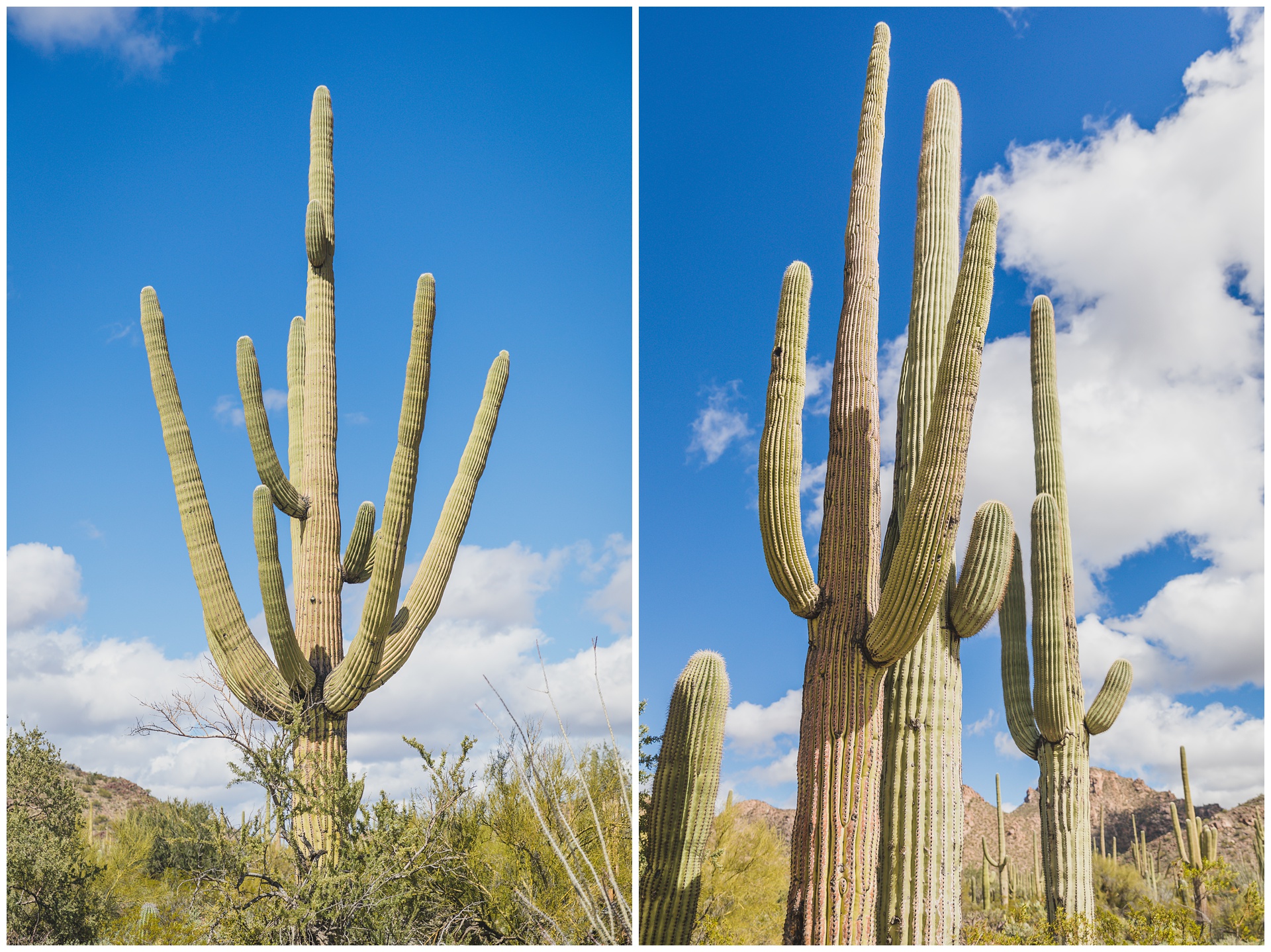


 The Valley View Overlook Trail was another hike with a lot of payoff for minimal effort, what with the towering saguaros all around. These cacti typically reach heights of 40 to 60 feet and can live to be 200 years old. It’s safe to say many of the ones we saw were much older than us, given that saguaros don’t start growing arms until they’re about 100!
The Valley View Overlook Trail was another hike with a lot of payoff for minimal effort, what with the towering saguaros all around. These cacti typically reach heights of 40 to 60 feet and can live to be 200 years old. It’s safe to say many of the ones we saw were much older than us, given that saguaros don’t start growing arms until they’re about 100!

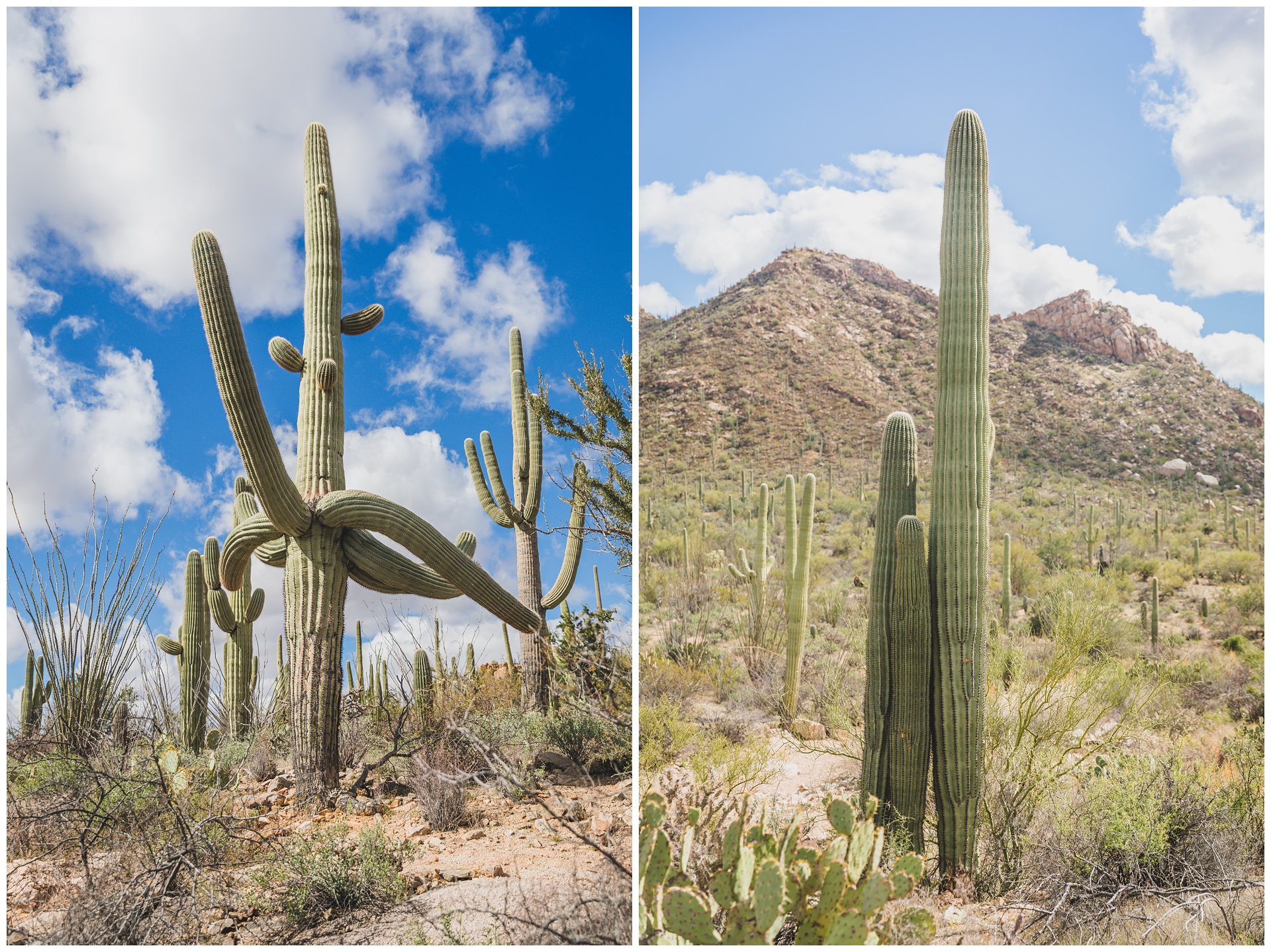

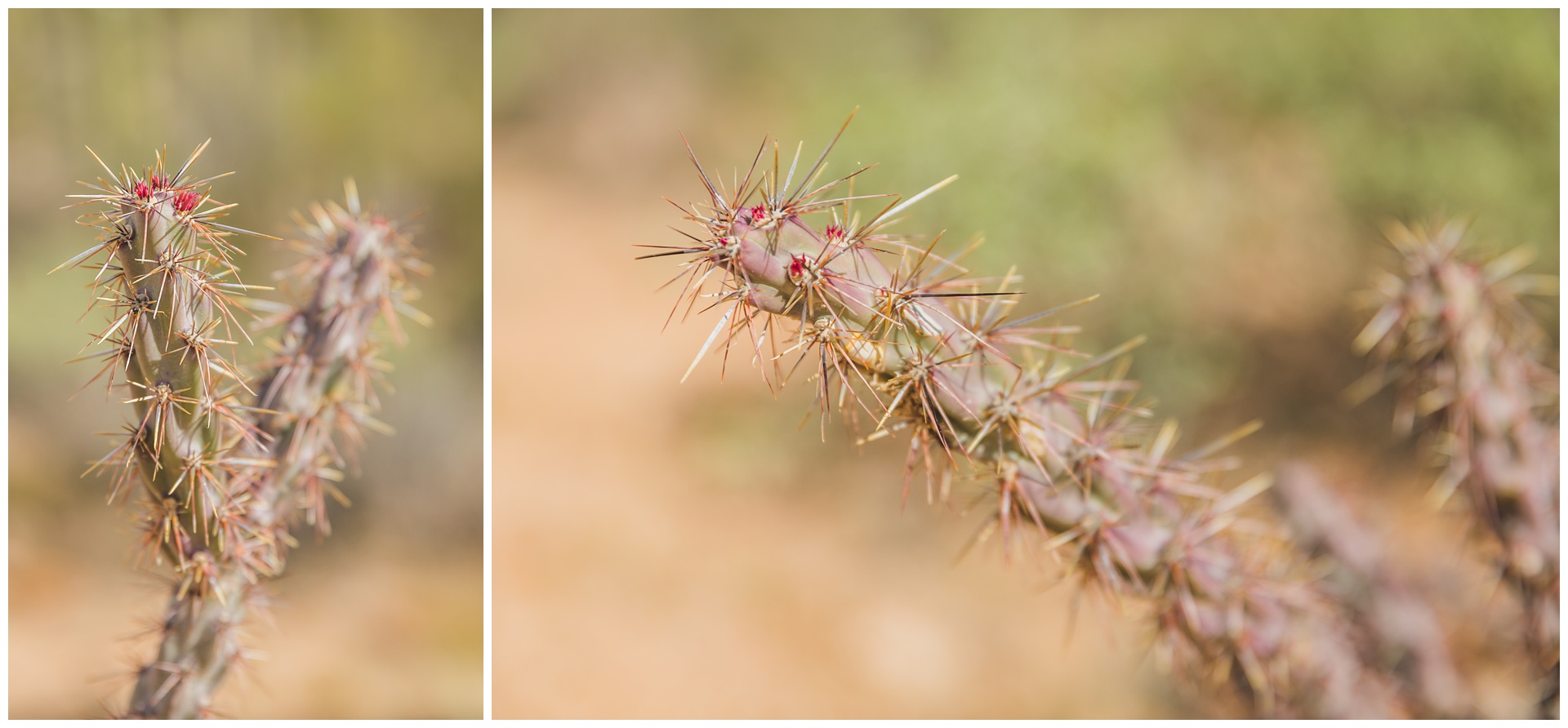







 Saguaros exist only in portions of the Sonoran Desert, which stretches from southwest Arizona into northwest Mexico. The pockets where they grow provide just the right temperature and rainfall. The Sonoran is the wettest desert in the world, with rainy seasons in both the winter and summer – yet even during these seasons, most days are sunny. This access to abundant water in a fairly warm climate allows saguaros to exist here, even as they’re absent everywhere else on Earth.
Saguaros exist only in portions of the Sonoran Desert, which stretches from southwest Arizona into northwest Mexico. The pockets where they grow provide just the right temperature and rainfall. The Sonoran is the wettest desert in the world, with rainy seasons in both the winter and summer – yet even during these seasons, most days are sunny. This access to abundant water in a fairly warm climate allows saguaros to exist here, even as they’re absent everywhere else on Earth.


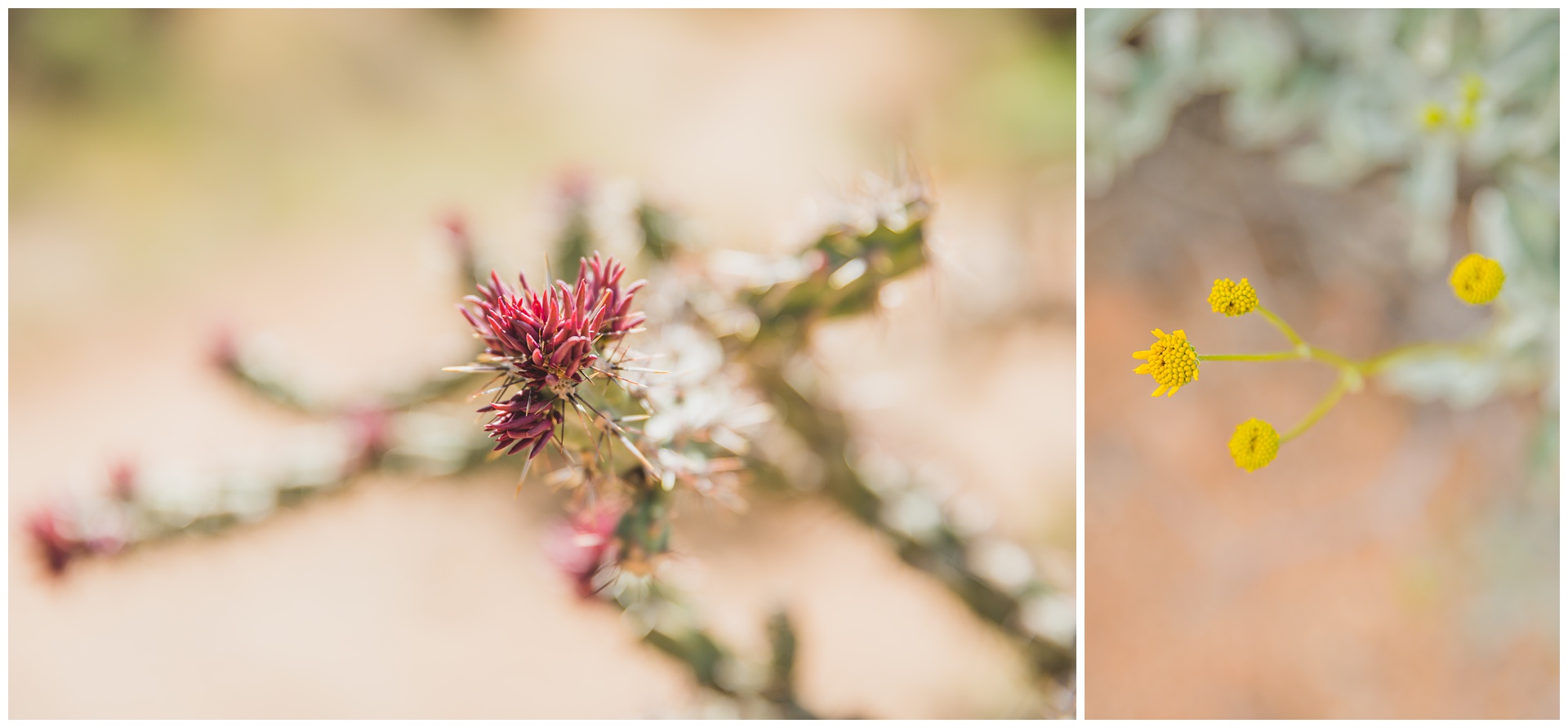





 Our final hike on the west side of the park was to Signal Hill, which in addition to more saguaros also showcases ancient petroglyphs:
Our final hike on the west side of the park was to Signal Hill, which in addition to more saguaros also showcases ancient petroglyphs:





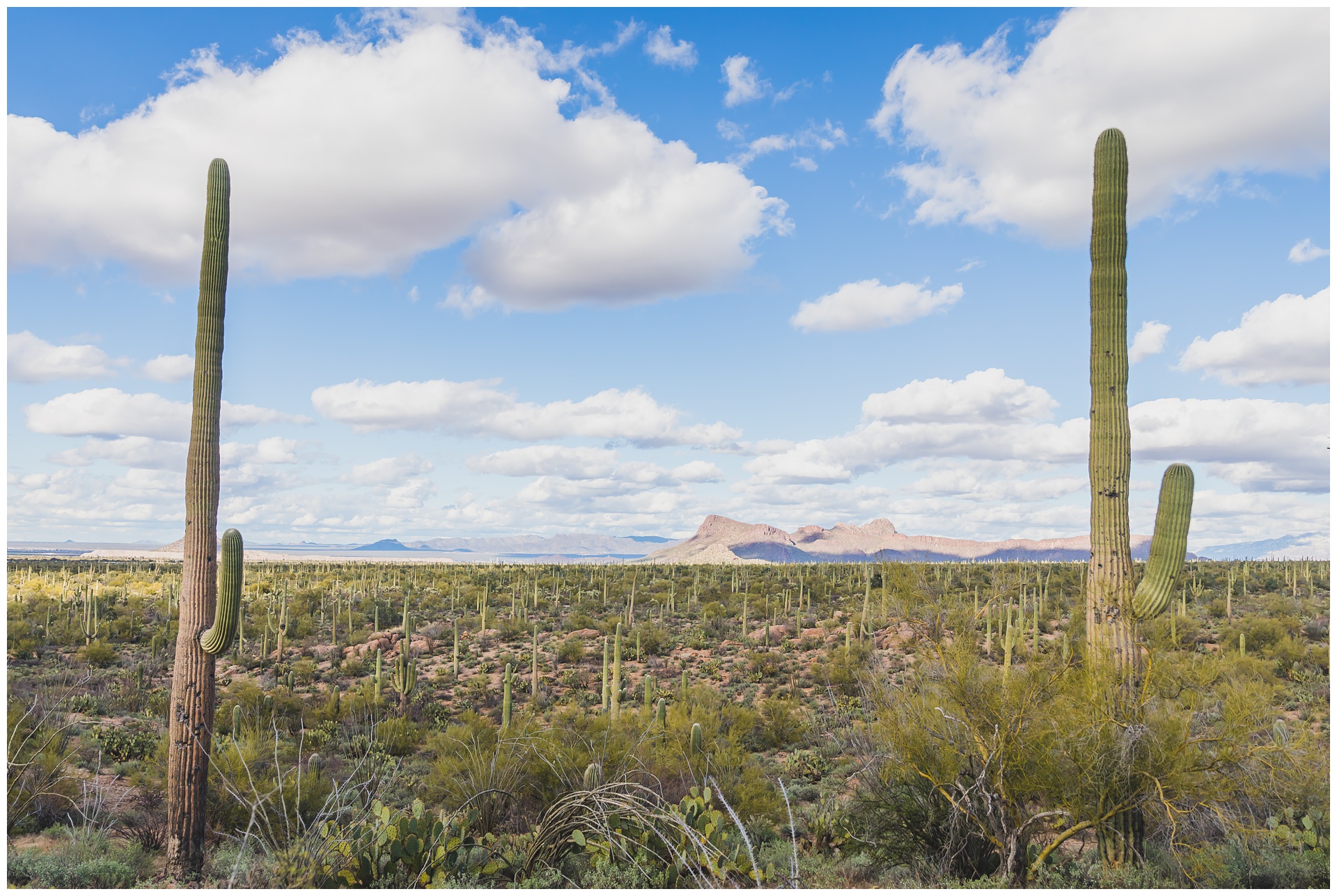



 We wanted to see the sun set from Gates Pass in the neighboring Tucson Mountain Park – and an added bonus of this location change was being able to fly our drone (which isn’t allowed within the boundaries of National Parks).
We wanted to see the sun set from Gates Pass in the neighboring Tucson Mountain Park – and an added bonus of this location change was being able to fly our drone (which isn’t allowed within the boundaries of National Parks).



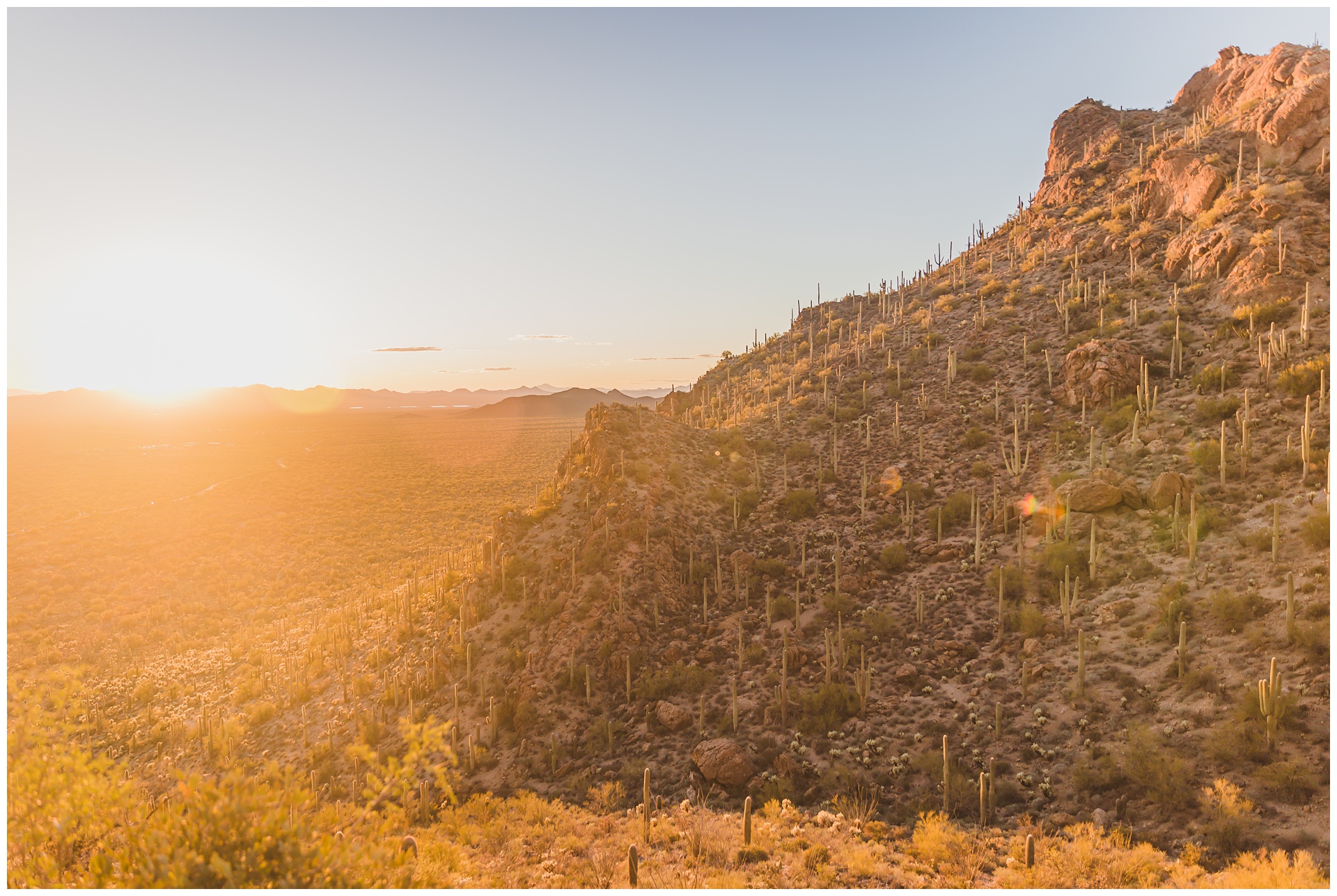 A sunset over saguaros – what a beautiful way to end the day!
A sunset over saguaros – what a beautiful way to end the day!


day 3 • 02.27.23
Saguaro National Park East (Rincon Mountain District)
 From our hotel on the west side of Tucson, we drove across the city to reach the eastern district of Saguaro and made stops at some murals along the way:
From our hotel on the west side of Tucson, we drove across the city to reach the eastern district of Saguaro and made stops at some murals along the way:




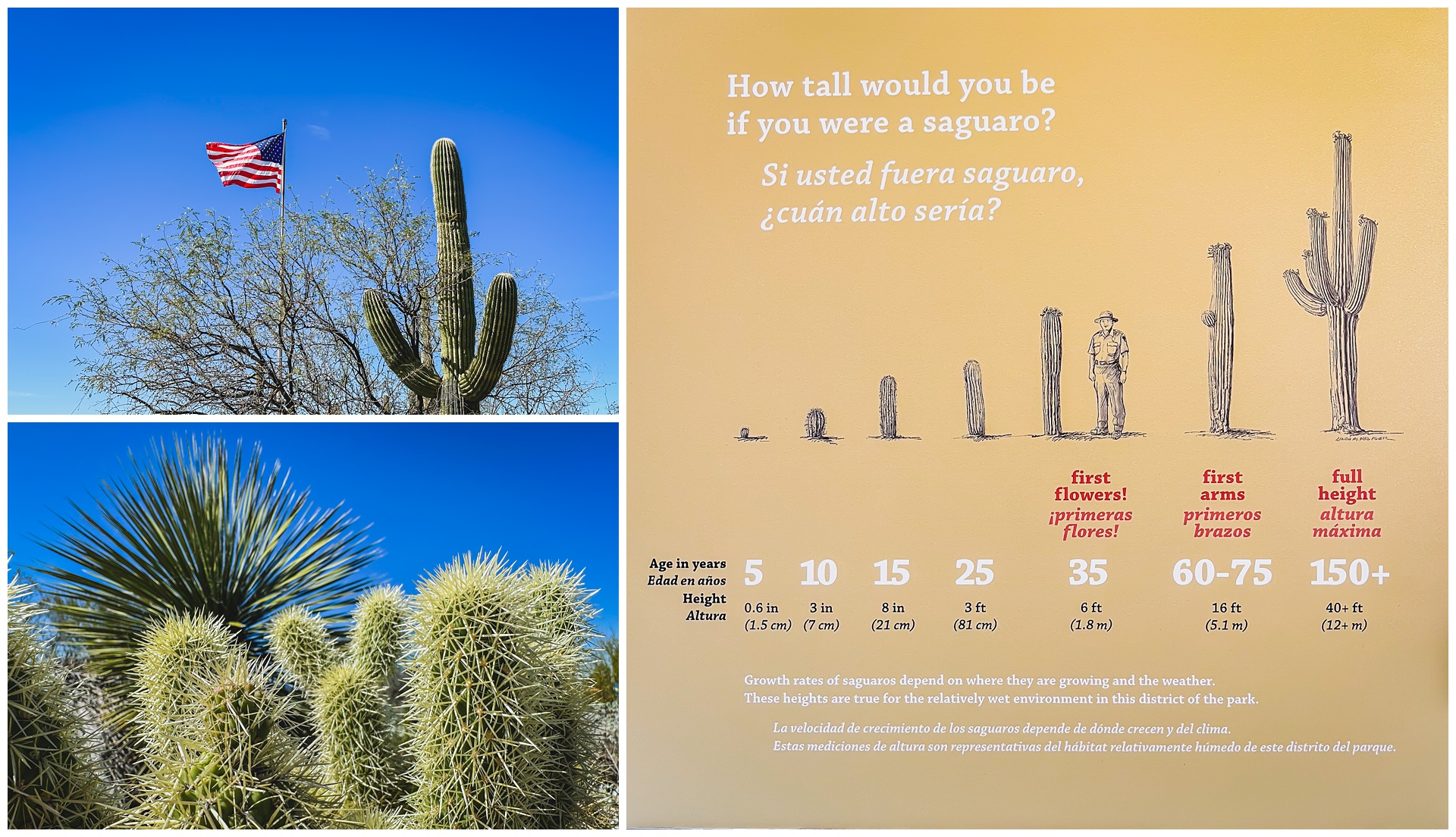 Because the Rincon Mountains on the east side of the park are significantly taller than the Tucson Mountains on the west – and thus force significantly more moisture from the air – there’s more variety here in terms of plant and animal life. But the saguaros are of course still the stars of the show!
Because the Rincon Mountains on the east side of the park are significantly taller than the Tucson Mountains on the west – and thus force significantly more moisture from the air – there’s more variety here in terms of plant and animal life. But the saguaros are of course still the stars of the show!
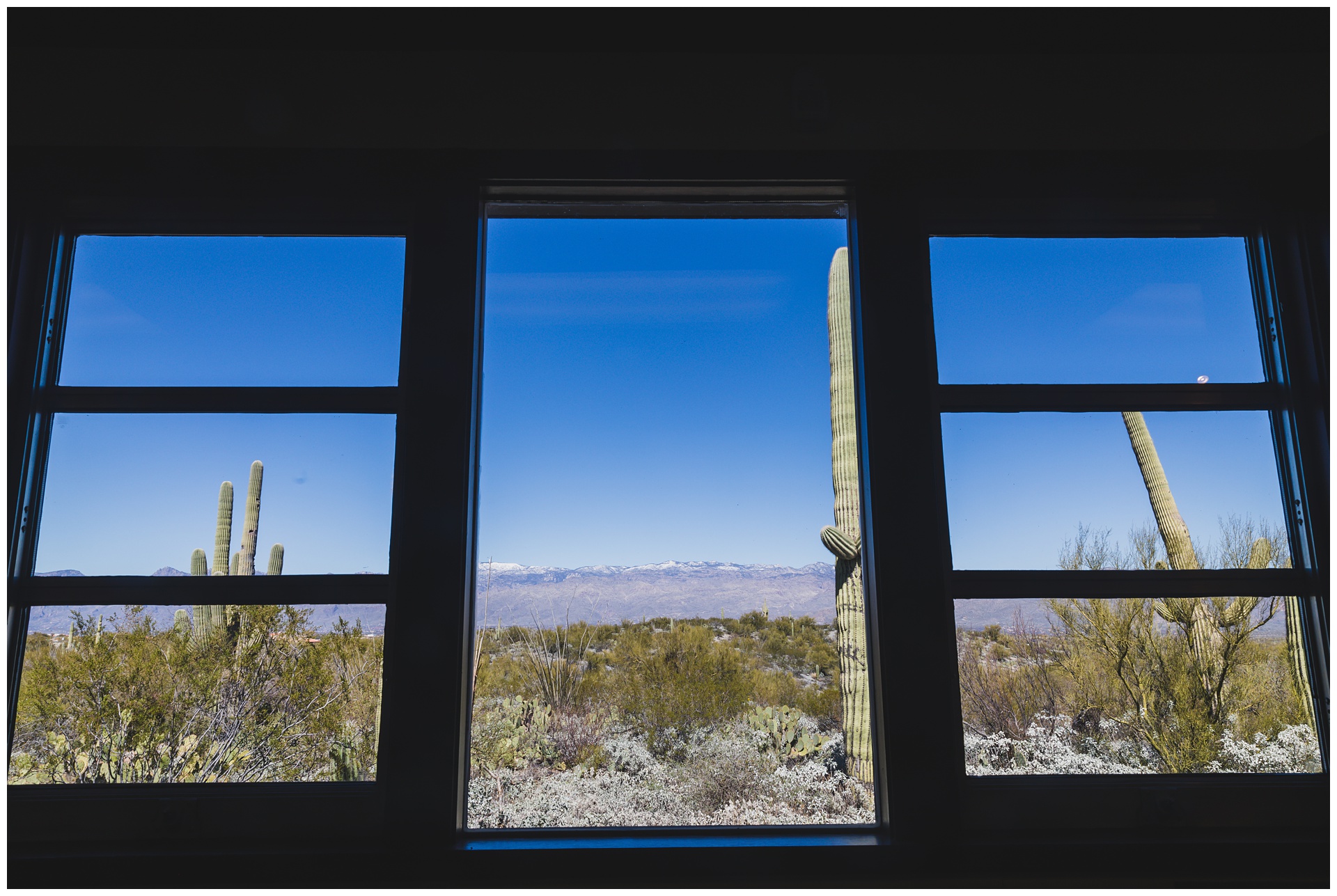

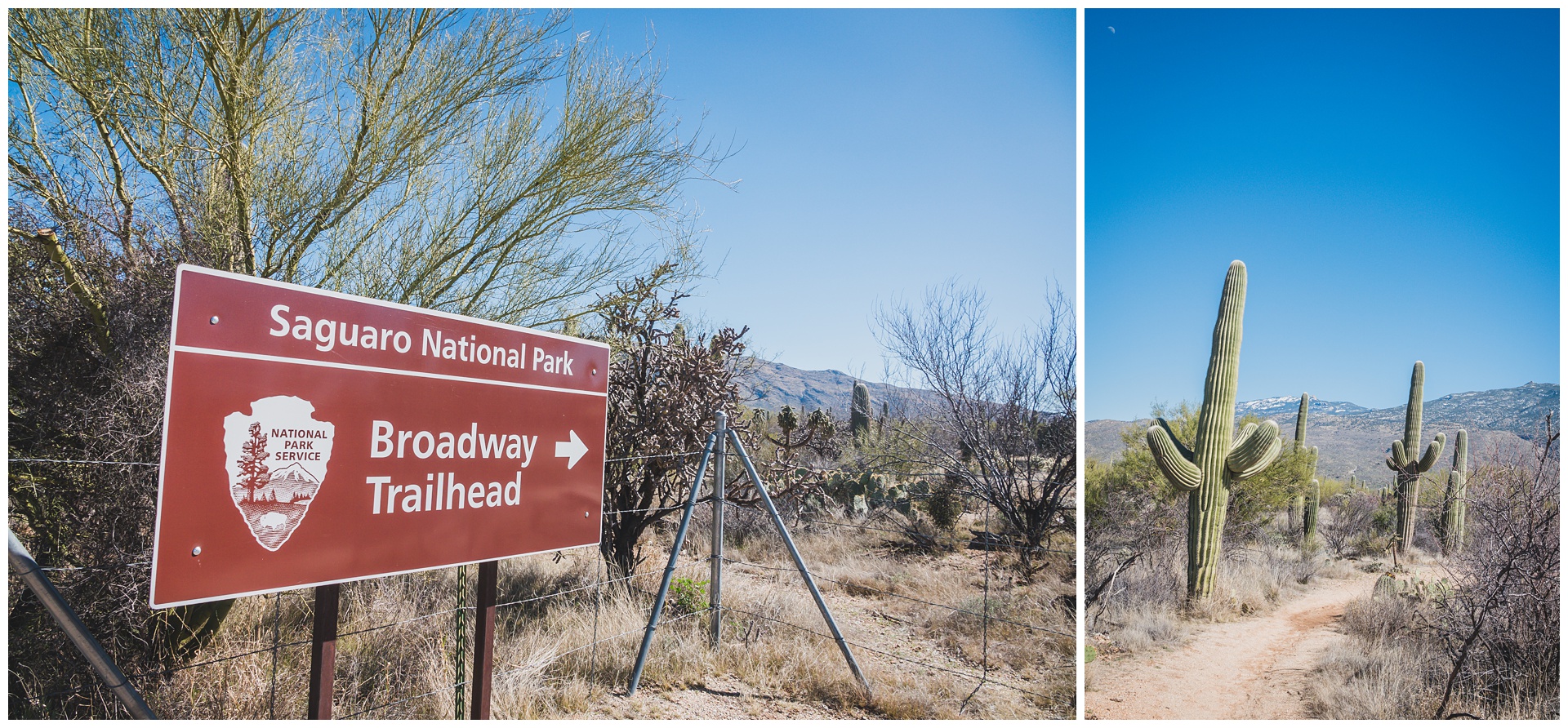 We set out to hike about 4 miles from the Broadway Trailhead but didn’t have to go far before encountering a cactus that stretched higher than the moon (at least in the shot at below left)!
We set out to hike about 4 miles from the Broadway Trailhead but didn’t have to go far before encountering a cactus that stretched higher than the moon (at least in the shot at below left)!

 With this trip falling just two weeks after the Chiefs won the Super Bowl in Arizona, it seemed especially fitting and celebratory to wear a Super Bowl shirt complete with saguaros.
With this trip falling just two weeks after the Chiefs won the Super Bowl in Arizona, it seemed especially fitting and celebratory to wear a Super Bowl shirt complete with saguaros.


 Along this trail, we came across a cristate (or crested) saguaro. That malformation at the top is due to a mutation – but despite those negative terms, it actually looks pretty awesome! It also reminded me of the clickers in “The Last of Us,” so I dubbed it the Clicker Cactus.
Along this trail, we came across a cristate (or crested) saguaro. That malformation at the top is due to a mutation – but despite those negative terms, it actually looks pretty awesome! It also reminded me of the clickers in “The Last of Us,” so I dubbed it the Clicker Cactus.





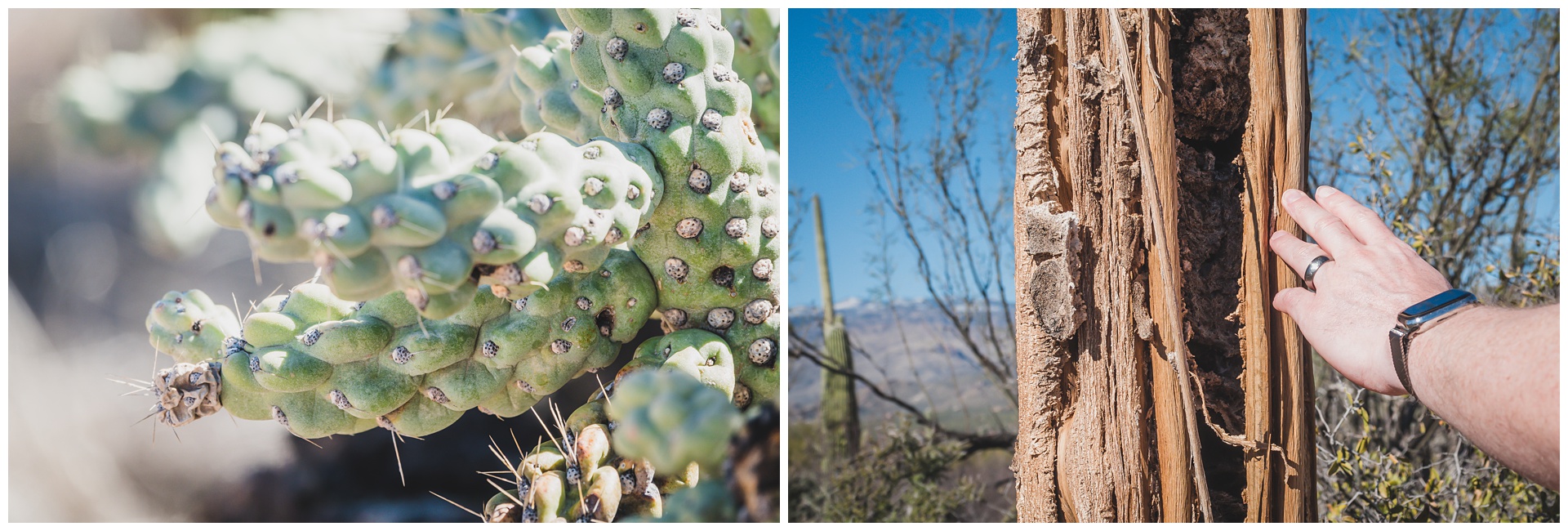






 Take it from Seth: Cactus needles don’t come out easily!
Take it from Seth: Cactus needles don’t come out easily!




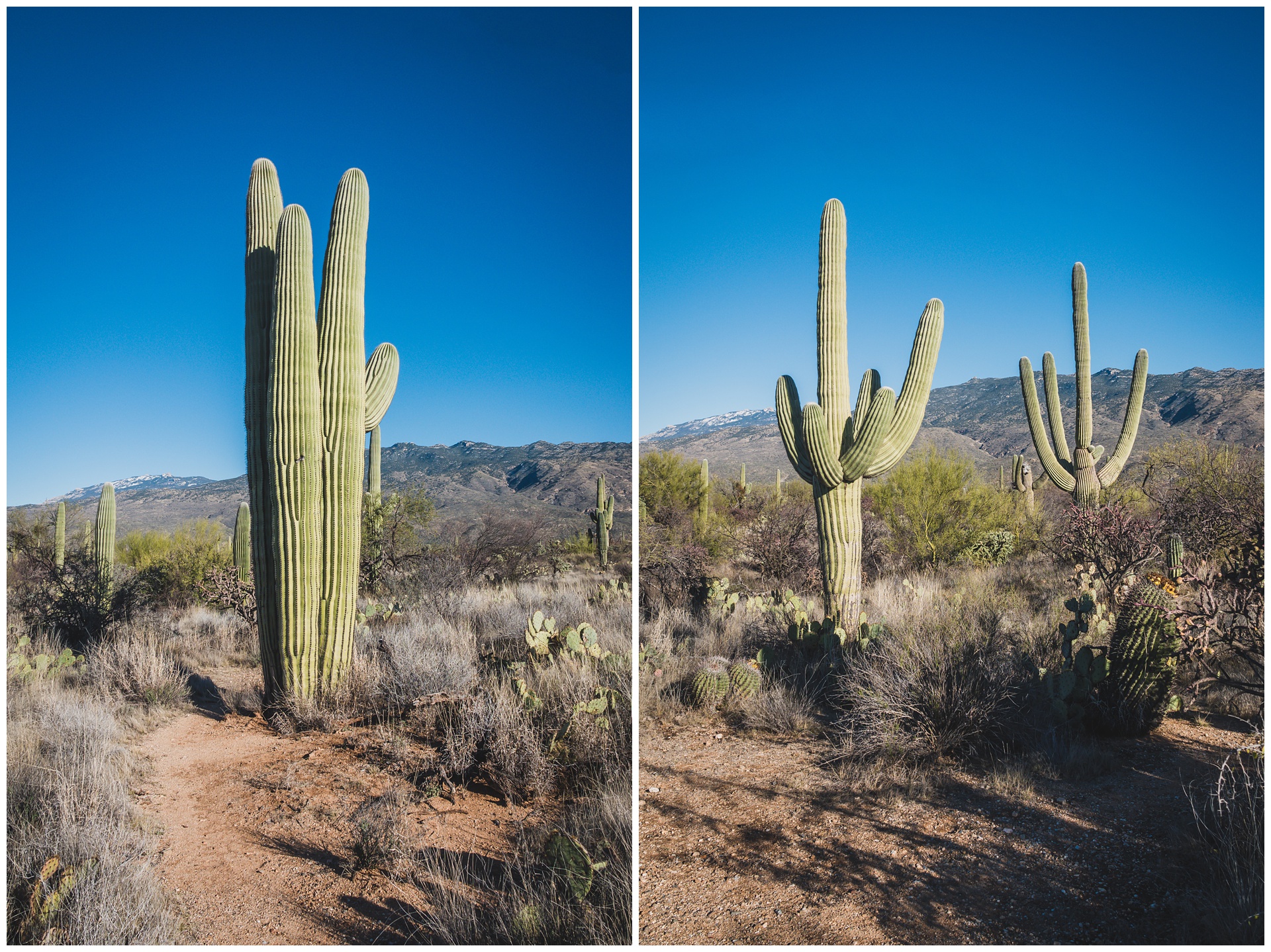
 Showing off our Chiefs championship apparel and then (below left) inadvertently posing pretty perfectly like the cactus behind us. That truly wasn’t planned at all, which made it a fun discovery after the fact!
Showing off our Chiefs championship apparel and then (below left) inadvertently posing pretty perfectly like the cactus behind us. That truly wasn’t planned at all, which made it a fun discovery after the fact!
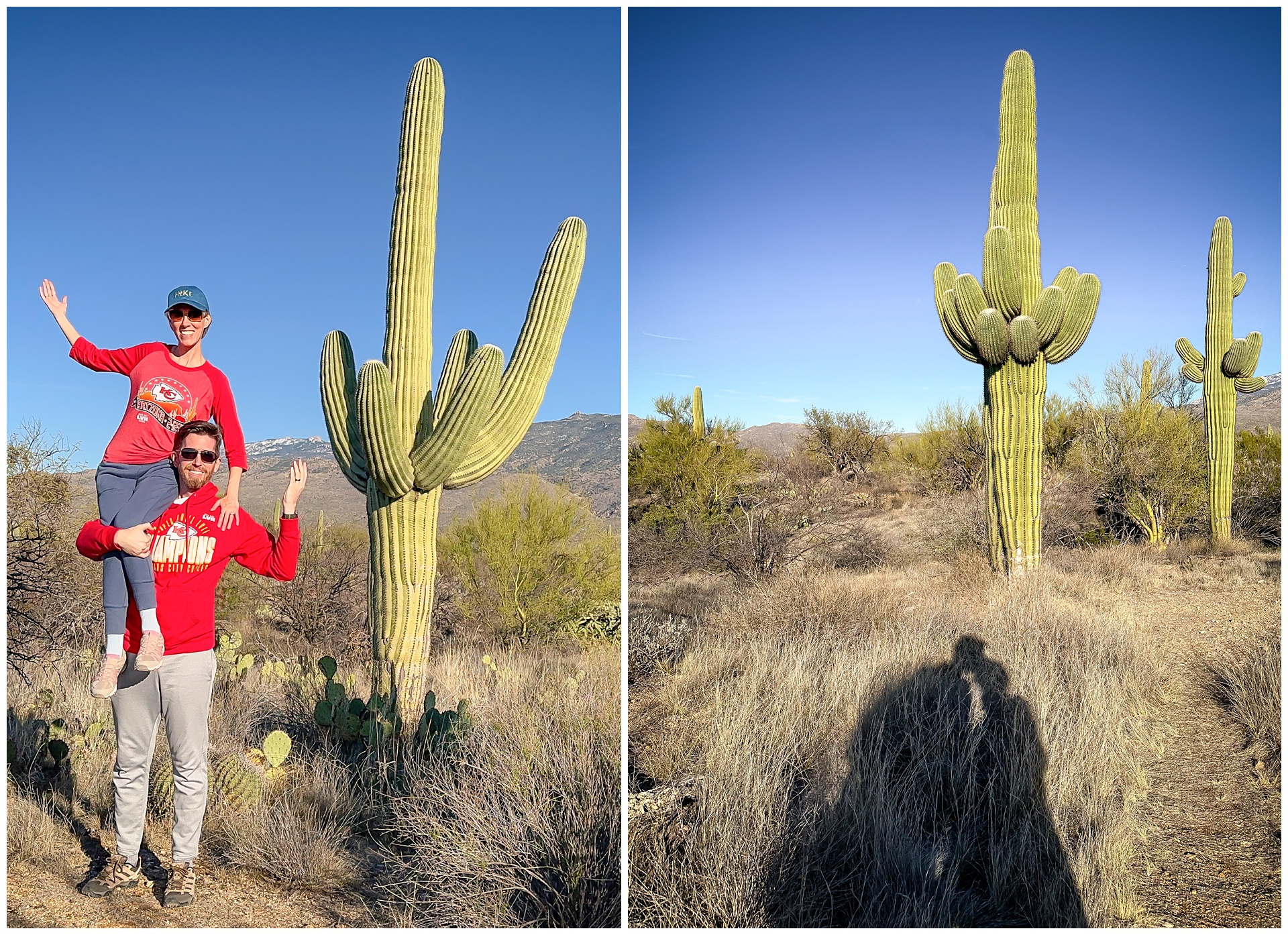

 We ended the day on Cactus Forest Drive, searching for just the right light and locations for a few “fancier” portraits. I’d definitely watch a show where photographers are dropped in an unfamiliar location within an hour of sunset and given this kind of challenge – complete with an in-car outfit change and, in this case, the need to avoid rattlesnake encounters!
We ended the day on Cactus Forest Drive, searching for just the right light and locations for a few “fancier” portraits. I’d definitely watch a show where photographers are dropped in an unfamiliar location within an hour of sunset and given this kind of challenge – complete with an in-car outfit change and, in this case, the need to avoid rattlesnake encounters!






 Near the end of the road was Javelina Rocks, another great sunset spot. We ended up arriving just after sunset but still get to enjoy some great color in the sky.
Near the end of the road was Javelina Rocks, another great sunset spot. We ended up arriving just after sunset but still get to enjoy some great color in the sky.



 After the sky went dark, we found some more color at an Eegee’s beside our hotel. I wouldn’t normally highlight a fast food stop, but this is a chain that began in Tucson and exists only in Arizona – so let’s call this a capture of some local culture!
After the sky went dark, we found some more color at an Eegee’s beside our hotel. I wouldn’t normally highlight a fast food stop, but this is a chain that began in Tucson and exists only in Arizona – so let’s call this a capture of some local culture!

day 4 • 02.28.23
A trip to Tombstone & one last Saguaro sunset
 A little more than an hour southeast of Tucson is the iconic Wild West town of Tombstone, famous for the O.K. Corral gunfight featuring Wyatt Earp. We figured that since we were so close, it was worth making a day trip to see this piece of history in person.
A little more than an hour southeast of Tucson is the iconic Wild West town of Tombstone, famous for the O.K. Corral gunfight featuring Wyatt Earp. We figured that since we were so close, it was worth making a day trip to see this piece of history in person.

 The Bird Cage Theatre is one of the only institutions in Tombstone still in its original structure. This building dates back to 1881, just two years after the town’s founding. And true to a town with fairly lawless and wild origins, its walls bear more than 140 bullet holes.
The Bird Cage Theatre is one of the only institutions in Tombstone still in its original structure. This building dates back to 1881, just two years after the town’s founding. And true to a town with fairly lawless and wild origins, its walls bear more than 140 bullet holes.

 Allen Street, the main thoroughfare through Tombstone’s historic section, remains a dirt road that’s closed to all traffic except horse-drawn stage coaches. After exploring the shops along this street, we made our way to the O.K. Corral for a reenactment of the 1881 gunfight that made Tombstone famous. On the flight home from Tucson, I listened to a podcast that speculated the reason this fight became so well known and went on to be the subject of multiple movies was that it perfectly fit the stereotypical picture of what the Wild West was.
Allen Street, the main thoroughfare through Tombstone’s historic section, remains a dirt road that’s closed to all traffic except horse-drawn stage coaches. After exploring the shops along this street, we made our way to the O.K. Corral for a reenactment of the 1881 gunfight that made Tombstone famous. On the flight home from Tucson, I listened to a podcast that speculated the reason this fight became so well known and went on to be the subject of multiple movies was that it perfectly fit the stereotypical picture of what the Wild West was.


 The actual gunfight sight (below) is an alleyway adjacent to where the reenactment takes place.
The actual gunfight sight (below) is an alleyway adjacent to where the reenactment takes place.

 Also in the area of the O.K. Corral are some museum displays. And while we didn’t ride a stage coach, I did hop on a coin-operated horse – leading to this photo Seth said should be called “There’s a new sheriff in town”:
Also in the area of the O.K. Corral are some museum displays. And while we didn’t ride a stage coach, I did hop on a coin-operated horse – leading to this photo Seth said should be called “There’s a new sheriff in town”:




 After looking around Tombstone a little more, we decided to head back to Tucson in time for one last stop at Saguaro – but not before grabbing the above shot of me with my shooting “weapon” of choice in front of the famous gunfight sight.
After looking around Tombstone a little more, we decided to head back to Tucson in time for one last stop at Saguaro – but not before grabbing the above shot of me with my shooting “weapon” of choice in front of the famous gunfight sight.

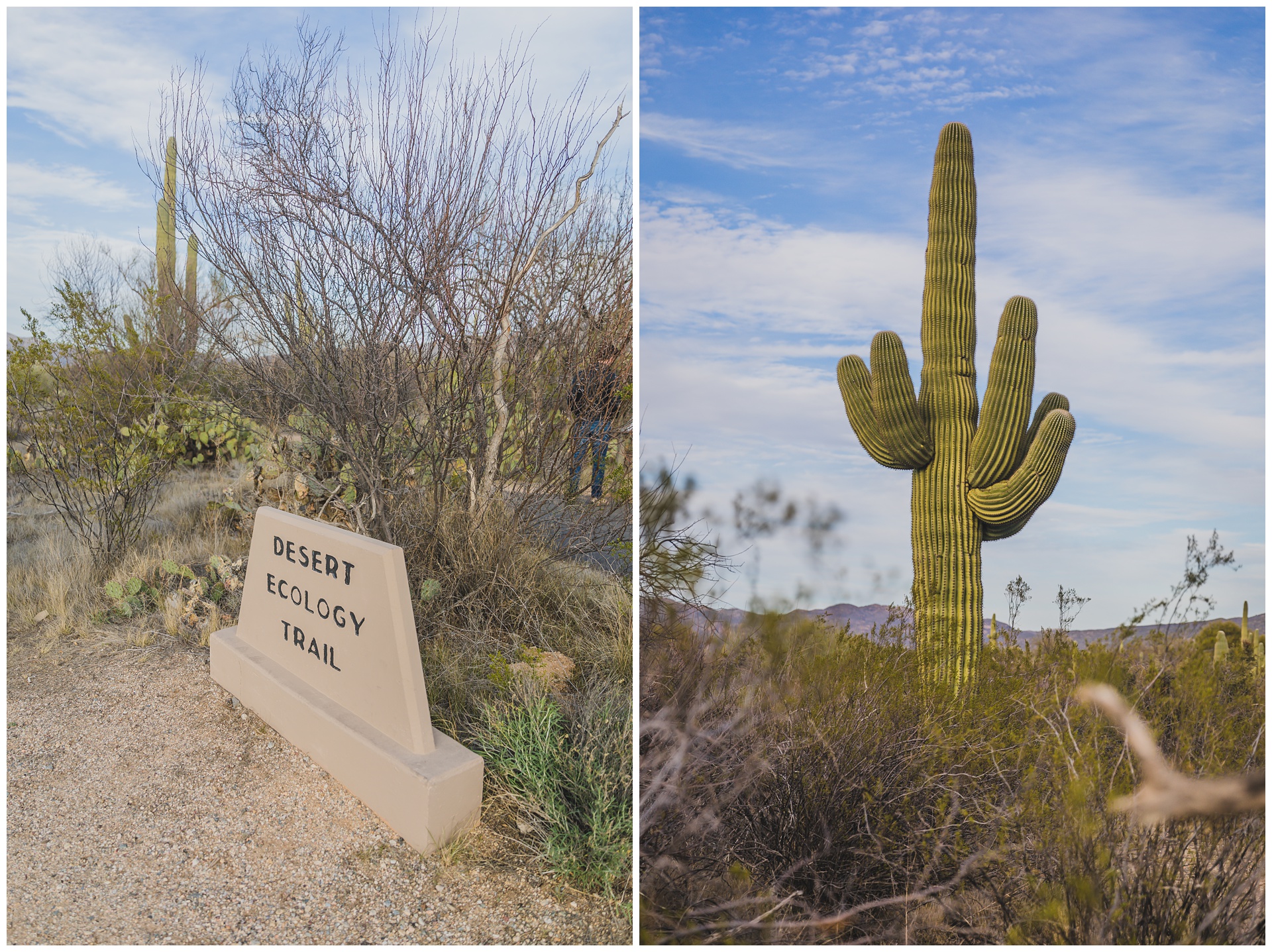 We went back to Saguaro’s eastern district and took another spin around Cactus Forest Drive, this time stopping to walk the Desert Ecology Trail.
We went back to Saguaro’s eastern district and took another spin around Cactus Forest Drive, this time stopping to walk the Desert Ecology Trail.
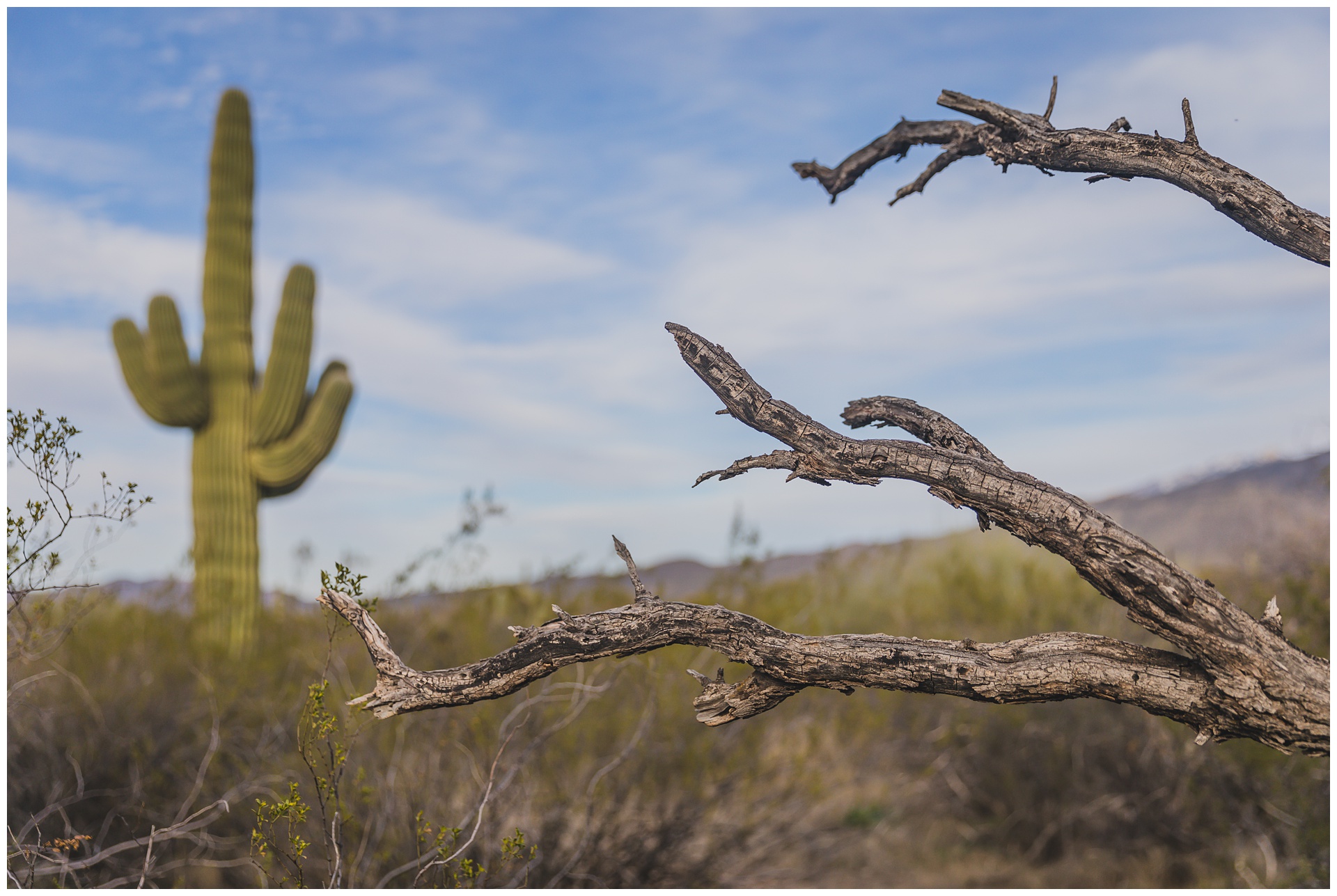






 Finally, we stopped again at Javalina Rocks – this time early enough to see the sun set. And what a sunset it was!
Finally, we stopped again at Javalina Rocks – this time early enough to see the sun set. And what a sunset it was!




day 5 • 03.01.23
Historic Tucson & a brand new terminal
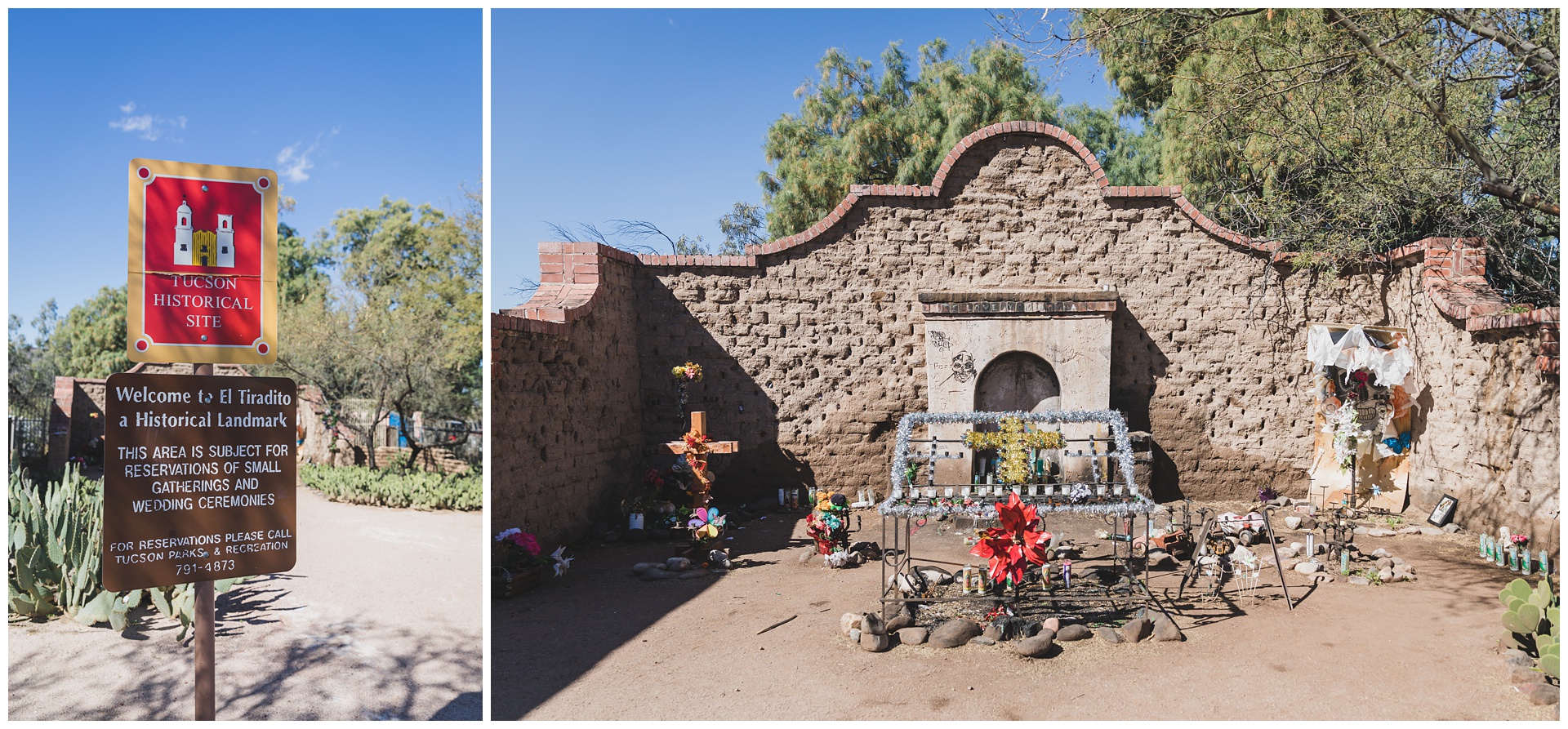 With our flight home not leaving until late afternoon, we had time to take in a few more historic Tucson sights. We started in the Barrio Viejo neighborhood at El Tiradito Wishing Shrine, which is on the National Register of Historic Places. Papers with prayers fill the cracks of the shrine’s walls, and legend has it that if you leave a candle with your wish and it burns all night, the wish will come true.
With our flight home not leaving until late afternoon, we had time to take in a few more historic Tucson sights. We started in the Barrio Viejo neighborhood at El Tiradito Wishing Shrine, which is on the National Register of Historic Places. Papers with prayers fill the cracks of the shrine’s walls, and legend has it that if you leave a candle with your wish and it burns all night, the wish will come true.
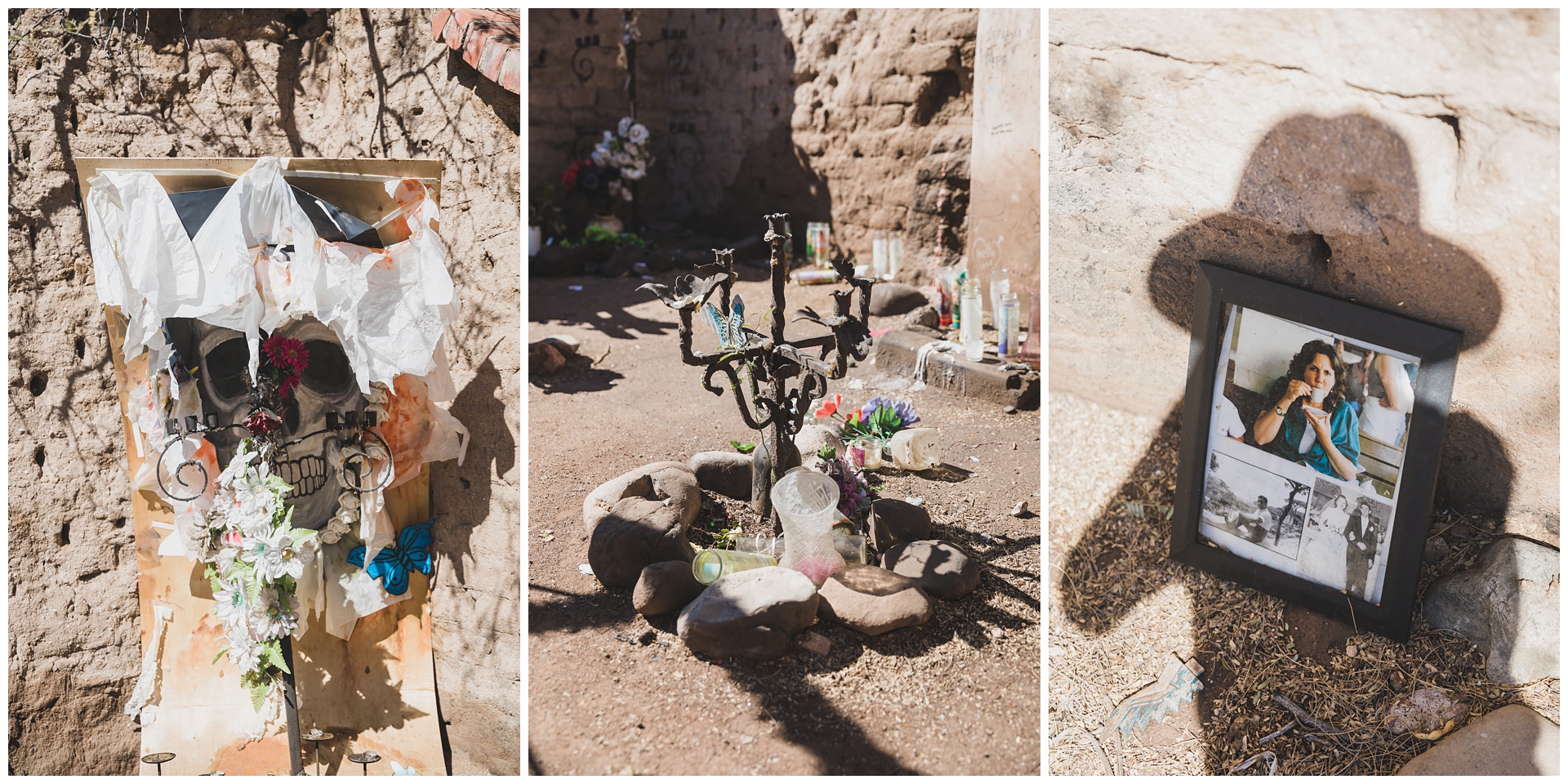




 Also in Barrio Viejo (which translates to “old neighborhood”) is Teatro Carmen, one of the first theaters in Tucson devoted exclusively to Spanish-language productions. The neighborhood itself is known for its brightly colored adobe homes dating back to the 1800s – some of them perhaps predating the United States’ acquisition of Tucson from Mexico.
Also in Barrio Viejo (which translates to “old neighborhood”) is Teatro Carmen, one of the first theaters in Tucson devoted exclusively to Spanish-language productions. The neighborhood itself is known for its brightly colored adobe homes dating back to the 1800s – some of them perhaps predating the United States’ acquisition of Tucson from Mexico.
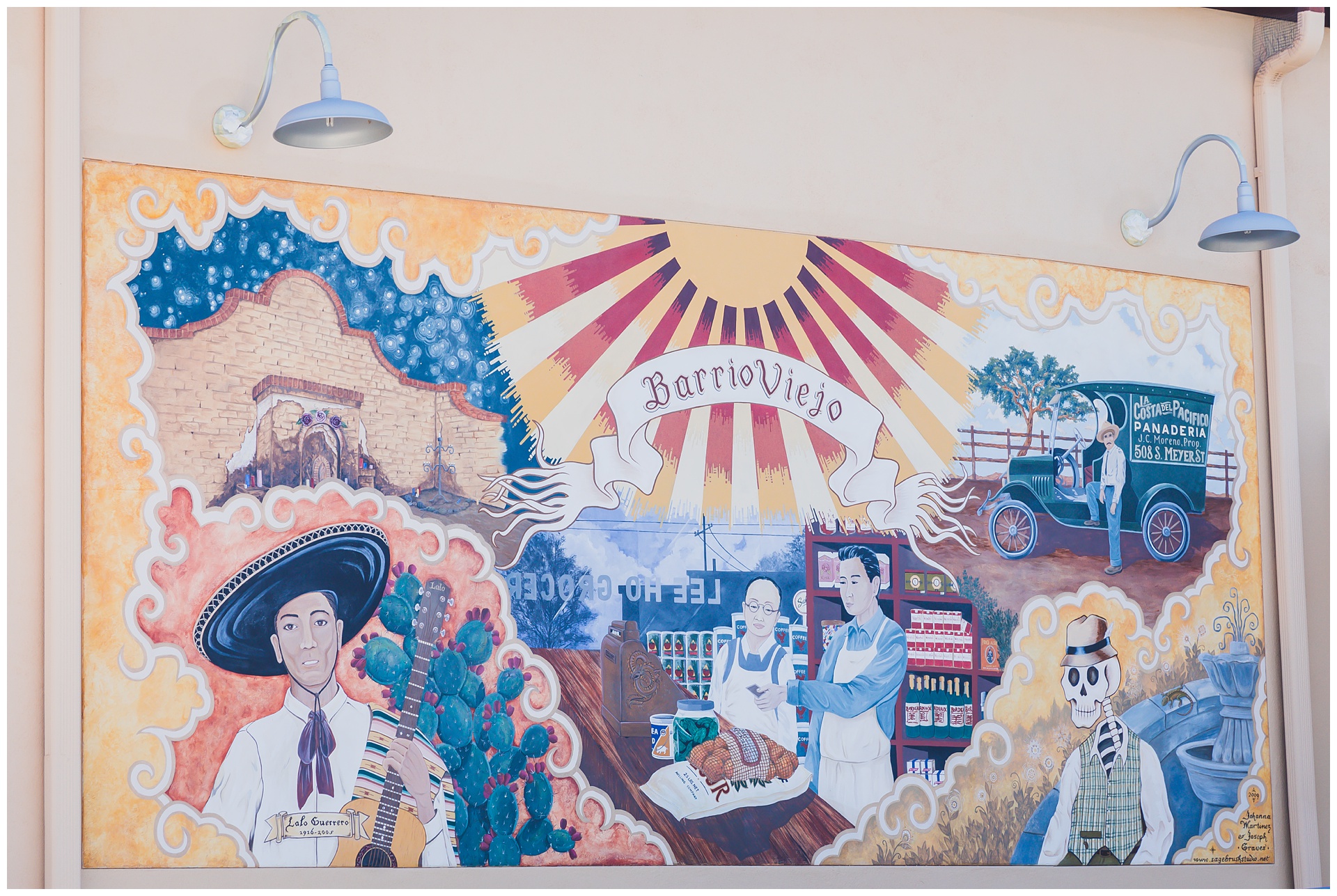

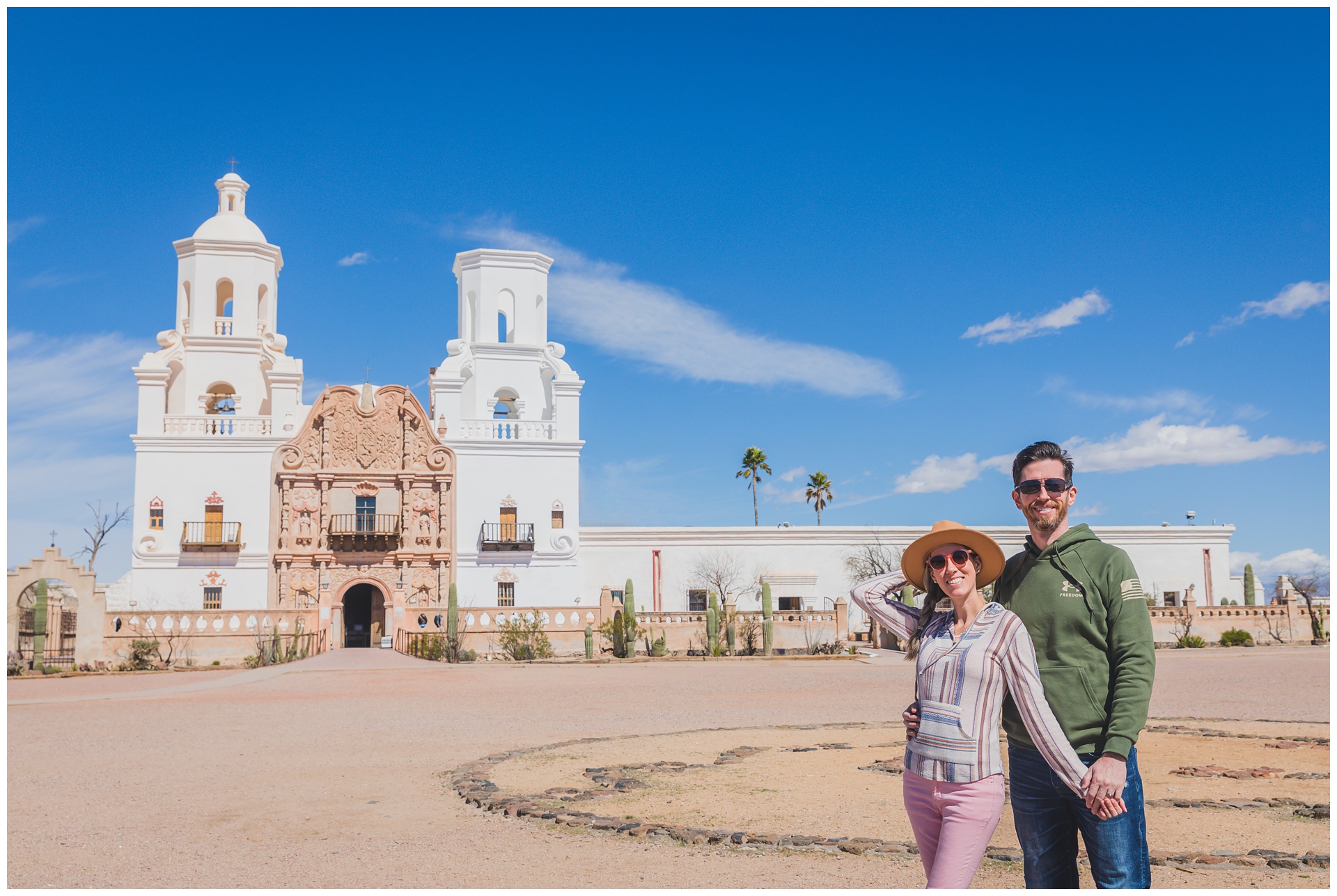 Last on our list was the San Xavier del Bac Mission. This historic Catholic mission was established in 1692, although the current building wasn’t completed for more than a century, until 1797. Still, it holds the status of being the oldest intact European structure in Arizona – actually far predating the formation of the state – and is on the National Register of Historic Places.
Last on our list was the San Xavier del Bac Mission. This historic Catholic mission was established in 1692, although the current building wasn’t completed for more than a century, until 1797. Still, it holds the status of being the oldest intact European structure in Arizona – actually far predating the formation of the state – and is on the National Register of Historic Places.



 At the airport, we were somewhat surprised to see Chiefs Super Bowl shirts. They were priced way cheaper than at home – so evidently the trick to getting a good deal was simply to shop in Tucson!
At the airport, we were somewhat surprised to see Chiefs Super Bowl shirts. They were priced way cheaper than at home – so evidently the trick to getting a good deal was simply to shop in Tucson!

 We arrived in Kansas City at midnight and had the new terminal mostly to ourselves. It smelled a little like a new car and was exciting to see.
We arrived in Kansas City at midnight and had the new terminal mostly to ourselves. It smelled a little like a new car and was exciting to see.


 I especially liked the paper-airplane art at baggage claim, and the only thing we weren’t super impressed with was design of the pick-up area (although presumably some of the problems there were from people not yet using it properly). In any case: Coming home to a new airport was a great end to this adventure!
I especially liked the paper-airplane art at baggage claim, and the only thing we weren’t super impressed with was design of the pick-up area (although presumably some of the problems there were from people not yet using it properly). In any case: Coming home to a new airport was a great end to this adventure!


I'm a print-journalist-turned-wedding-photographer who fully believes in the value of telling true stories beautifully. By means of a camera, I am a curator so my clients can be keepers of their most important moments.
start here
weddings over here:
take this quiz to create
a timeline for your day!
a nature trail
session in autumn
an elegant summer wedding at the elms
TIPS FOR TOP-NOTCH TRAVEL PHOTOGRAPHY
weatherproof
your wedding day